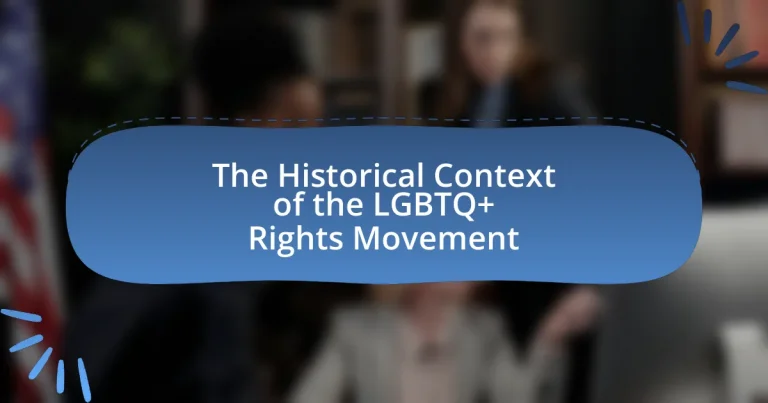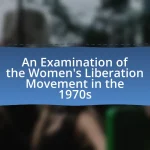The article examines the historical context of the LGBTQ+ rights movement, tracing its roots from mid-20th century struggles for equality to significant milestones such as the Stonewall Riots in 1969 and the legalization of same-sex marriage in the United States in 2015. It discusses the evolution of societal attitudes towards LGBTQ+ individuals, key historical events that shaped these perceptions, and the impact of legislation on the movement. Additionally, the article highlights ongoing challenges faced by the LGBTQ+ community, including discrimination and violence, while emphasizing the importance of intersectionality and the role of allies in promoting equality and inclusion.

What is the Historical Context of the LGBTQ+ Rights Movement?
The historical context of the LGBTQ+ rights movement is rooted in the social and political struggles for equality and acceptance that began in the mid-20th century. The movement gained significant momentum following the Stonewall Riots in 1969, which were a response to police raids on LGBTQ+ bars in New York City, marking a pivotal moment in the fight against discrimination. Prior to this, LGBTQ+ individuals faced widespread criminalization and social stigma, with homosexuality classified as a mental illness by the American Psychiatric Association until 1973. The movement has since evolved, advocating for legal rights, including marriage equality, anti-discrimination laws, and broader societal acceptance, culminating in landmark achievements such as the legalization of same-sex marriage in the United States in 2015 through the Supreme Court case Obergefell v. Hodges.
How did societal attitudes towards LGBTQ+ individuals evolve over time?
Societal attitudes towards LGBTQ+ individuals have evolved significantly from widespread stigma and criminalization to increasing acceptance and legal recognition. In the early 20th century, homosexuality was often classified as a mental illness, and same-sex relationships were criminalized in many countries. The mid-20th century saw the emergence of the gay rights movement, particularly after the Stonewall Riots in 1969, which marked a pivotal moment in LGBTQ+ activism. By the late 20th and early 21st centuries, many societies began to decriminalize homosexuality, recognize same-sex marriages, and implement anti-discrimination laws. For instance, in 2003, the U.S. Supreme Court’s ruling in Lawrence v. Texas invalidated sodomy laws, reflecting a shift towards greater acceptance. Public opinion polls have shown a steady increase in support for LGBTQ+ rights, with a 2021 Gallup poll indicating that 70% of Americans support same-sex marriage, compared to just 27% in 1996. This evolution illustrates a broader societal shift towards inclusivity and equality for LGBTQ+ individuals.
What were the key historical events that shaped these attitudes?
Key historical events that shaped attitudes towards LGBTQ+ rights include the Stonewall Riots of 1969, which marked a pivotal moment in the fight for LGBTQ+ equality, leading to increased visibility and activism. The American Psychiatric Association’s decision in 1973 to remove homosexuality from its Diagnostic and Statistical Manual of Mental Disorders further contributed to changing perceptions, as it de-stigmatized LGBTQ+ identities. Additionally, the AIDS crisis in the 1980s galvanized the LGBTQ+ community and its allies, leading to greater advocacy for healthcare and rights. These events collectively influenced societal attitudes, fostering a movement towards acceptance and legal recognition of LGBTQ+ rights.
How did cultural influences impact the perception of LGBTQ+ individuals?
Cultural influences significantly shaped the perception of LGBTQ+ individuals by framing societal norms and values around sexuality and gender identity. For instance, in many Western societies, the rise of the LGBTQ+ rights movement in the late 20th century was influenced by cultural shifts such as the counterculture of the 1960s, which challenged traditional norms and promoted individual freedom. This cultural backdrop led to increased visibility and acceptance of LGBTQ+ individuals, as seen in events like the Stonewall Riots of 1969, which became a catalyst for activism and advocacy. Additionally, media representation has played a crucial role; positive portrayals of LGBTQ+ characters in television and film have contributed to changing perceptions, fostering empathy and understanding among broader audiences. Studies indicate that increased representation correlates with greater acceptance, highlighting the impact of cultural narratives on societal attitudes toward LGBTQ+ individuals.
What role did legislation play in the LGBTQ+ rights movement?
Legislation played a crucial role in the LGBTQ+ rights movement by establishing legal protections and recognition for LGBTQ+ individuals. Key legislative milestones, such as the decriminalization of homosexuality in various countries and the legalization of same-sex marriage, have significantly advanced LGBTQ+ rights. For instance, the U.S. Supreme Court’s decision in Obergefell v. Hodges (2015) legalized same-sex marriage nationwide, affirming the constitutional right to marry for same-sex couples. Additionally, anti-discrimination laws, such as the Employment Non-Discrimination Act (ENDA), have aimed to protect LGBTQ+ individuals from workplace discrimination, further solidifying their rights within society. These legislative actions have not only provided legal recognition but also fostered social acceptance and equality for LGBTQ+ individuals.
Which laws were significant in the early history of LGBTQ+ rights?
The significant laws in the early history of LGBTQ+ rights include the decriminalization of homosexuality in various jurisdictions, such as the 1962 Illinois law that became the first to repeal laws against consensual same-sex relations. Additionally, the 1973 decision by the American Psychiatric Association to remove homosexuality from its Diagnostic and Statistical Manual of Mental Disorders marked a pivotal shift in societal perceptions and legal treatment of LGBTQ+ individuals. These legal changes laid the groundwork for subsequent advancements in LGBTQ+ rights and recognition.
How did legal battles influence public opinion and policy changes?
Legal battles significantly influenced public opinion and policy changes regarding LGBTQ+ rights by bringing visibility to issues of discrimination and equality. Landmark cases, such as Obergefell v. Hodges in 2015, which legalized same-sex marriage in the United States, shifted societal perceptions by framing LGBTQ+ rights as civil rights issues. This case, along with others like Lawrence v. Texas in 2003, which decriminalized same-sex intimacy, catalyzed public discourse and increased acceptance, as media coverage and public discussions highlighted the injustices faced by LGBTQ+ individuals. Consequently, these legal victories not only changed laws but also fostered a more supportive environment for LGBTQ+ rights, leading to broader policy changes at local, state, and federal levels.
What were the major milestones in the LGBTQ+ rights movement?
The major milestones in the LGBTQ+ rights movement include the Stonewall Riots in 1969, which marked a significant turning point in the fight for LGBTQ+ rights in the United States. Following this, the first Pride marches took place in 1970, commemorating the anniversary of the riots and promoting visibility. In 1973, the American Psychiatric Association declassified homosexuality as a mental disorder, a crucial step in combating stigma. The 1996 Defense of Marriage Act, which defined marriage as between one man and one woman, was challenged in subsequent years, leading to landmark Supreme Court cases. In 2015, the Supreme Court ruled in Obergefell v. Hodges that same-sex marriage is a constitutional right, solidifying marriage equality nationwide. These milestones collectively represent significant progress in the legal and social recognition of LGBTQ+ rights.
What events marked the beginning of organized activism?
The beginning of organized activism in the LGBTQ+ rights movement is marked by the formation of the Mattachine Society in 1950 and the Daughters of Bilitis in 1955. The Mattachine Society, founded by Harry Hay and others, aimed to advocate for gay rights and provide support for homosexuals facing discrimination. The Daughters of Bilitis, established by Del Martin and Phyllis Lyon, focused on lesbian rights and created a safe space for women to discuss their experiences. These organizations laid the groundwork for future activism by mobilizing individuals and raising awareness about LGBTQ+ issues, ultimately leading to more significant movements such as the Stonewall Riots in 1969, which further galvanized organized activism.
How did the Stonewall Riots impact the movement’s trajectory?
The Stonewall Riots significantly shifted the trajectory of the LGBTQ+ rights movement by catalyzing activism and increasing visibility for LGBTQ+ issues. Occurring in June 1969, the riots marked a turning point, leading to the formation of numerous advocacy organizations, such as the Gay Liberation Front, which sought to challenge systemic discrimination. The events at Stonewall galvanized a generation, inspiring annual Pride marches and fostering a sense of community and solidarity among LGBTQ+ individuals. This increased activism contributed to landmark legal changes, including the decriminalization of homosexuality in various jurisdictions and the eventual recognition of same-sex marriage. The riots are widely regarded as a pivotal moment that transformed the LGBTQ+ rights movement from a marginalized struggle into a prominent social justice movement.

How did the LGBTQ+ rights movement gain momentum in the 20th century?
The LGBTQ+ rights movement gained momentum in the 20th century primarily through increased visibility, activism, and legal challenges against discrimination. Key events such as the Stonewall Riots in 1969 marked a turning point, galvanizing the community and leading to the formation of various advocacy organizations. The American Psychological Association declassified homosexuality as a mental disorder in 1973, further legitimizing the movement. Additionally, the rise of the feminist movement and the civil rights movement provided a framework for LGBTQ+ activism, fostering solidarity and support. These factors collectively contributed to significant advancements in LGBTQ+ rights, including the eventual legalization of same-sex marriage in many countries by the early 21st century.
What were the key organizations that emerged during this period?
Key organizations that emerged during the historical context of the LGBTQ+ rights movement include the Mattachine Society, founded in 1950, and the Daughters of Bilitis, established in 1955. The Mattachine Society was one of the first gay rights organizations in the United States, advocating for the rights of gay men and promoting social acceptance. The Daughters of Bilitis was the first lesbian civil and political rights organization in the U.S., focusing on issues affecting women in the LGBTQ+ community. These organizations played crucial roles in raising awareness and mobilizing efforts for LGBTQ+ rights during a time of significant social and political challenges.
How did these organizations contribute to advocacy and awareness?
Organizations such as the Human Rights Campaign and the Gay Liberation Front significantly contributed to advocacy and awareness for LGBTQ+ rights by mobilizing communities, influencing legislation, and raising public consciousness. The Human Rights Campaign, for instance, has been instrumental in lobbying for legal protections against discrimination, evidenced by its role in the passage of the Employment Non-Discrimination Act. Similarly, the Gay Liberation Front was pivotal in organizing protests and events, such as the first Pride marches in 1970, which brought visibility to LGBTQ+ issues. These actions not only galvanized support within the LGBTQ+ community but also educated the broader public, leading to increased acceptance and policy changes over time.
What strategies did they employ to mobilize support?
The LGBTQ+ rights movement employed various strategies to mobilize support, including grassroots organizing, coalition-building, and public demonstrations. Grassroots organizing involved local activists forming community groups to raise awareness and advocate for rights at the local level. Coalition-building was crucial, as LGBTQ+ organizations partnered with civil rights groups, labor unions, and feminist movements to amplify their message and gain broader support. Public demonstrations, such as pride parades and protests, served to visibly showcase solidarity and demand equal rights, effectively drawing media attention and public interest. These strategies collectively helped to create a more inclusive dialogue around LGBTQ+ issues and fostered a sense of community and urgency for change.
How did the AIDS crisis affect the LGBTQ+ rights movement?
The AIDS crisis significantly accelerated the LGBTQ+ rights movement by highlighting the urgent need for healthcare access, social justice, and legal protections. As the epidemic disproportionately affected gay men, it galvanized activists to demand government action and funding for research and treatment, leading to the formation of organizations like ACT UP in 1987. This activism not only raised awareness about the disease but also brought broader issues of discrimination and inequality faced by the LGBTQ+ community into public discourse, ultimately contributing to the push for civil rights and legal recognition, such as marriage equality. The crisis underscored the importance of community solidarity and advocacy, shaping the trajectory of the movement in the following decades.
What were the immediate impacts of the crisis on the community?
The immediate impacts of the crisis on the LGBTQ+ community included heightened discrimination, increased violence, and a surge in activism. Following the crisis, many individuals faced social ostracism and job loss due to their sexual orientation or gender identity, as evidenced by reports from organizations like the Human Rights Campaign, which documented a rise in hate crimes during this period. Additionally, the crisis catalyzed a wave of grassroots movements, leading to the formation of support networks and advocacy groups aimed at fighting for rights and protections, as seen in the establishment of organizations such as ACT UP in response to the AIDS crisis.
How did activism change in response to the AIDS epidemic?
Activism transformed significantly in response to the AIDS epidemic by shifting focus towards urgent healthcare advocacy and community mobilization. In the 1980s, as the crisis escalated, organizations like ACT UP (AIDS Coalition to Unleash Power) emerged, emphasizing direct action and public demonstrations to demand government accountability and access to treatment. This activism was characterized by strategies such as die-ins, which highlighted the urgency of the epidemic and the inaction of authorities. The epidemic also catalyzed a more intersectional approach, addressing not only health disparities but also social justice issues affecting marginalized communities. The response to AIDS ultimately reshaped the LGBTQ+ rights movement, fostering a sense of solidarity and collective action that continues to influence activism today.

What are the ongoing challenges faced by the LGBTQ+ rights movement today?
The ongoing challenges faced by the LGBTQ+ rights movement today include discrimination, violence, and legal inequalities. Discrimination persists in various sectors, including employment and housing, where LGBTQ+ individuals often face bias, as evidenced by the 2021 Human Rights Campaign report indicating that 46% of LGBTQ+ Americans experienced discrimination. Violence against LGBTQ+ individuals, particularly transgender women of color, remains alarmingly high, with the FBI reporting a rise in hate crimes targeting this community. Additionally, legal inequalities exist in many regions, where same-sex marriage and adoption rights are still contested, highlighting the ongoing struggle for equal rights and protections under the law.
What legal and social issues continue to affect LGBTQ+ individuals?
Legal and social issues that continue to affect LGBTQ+ individuals include discrimination in employment, housing, and healthcare, as well as violence and hate crimes. For instance, a 2021 report by the Human Rights Campaign indicated that LGBTQ+ individuals face higher rates of unemployment and homelessness compared to their heterosexual counterparts. Additionally, many states lack comprehensive non-discrimination laws, leaving LGBTQ+ individuals vulnerable to legal inequalities. Socially, stigma and prejudice persist, contributing to mental health challenges and social isolation within the community. The FBI’s Hate Crime Statistics report shows that hate crimes against LGBTQ+ individuals remain a significant concern, highlighting ongoing societal violence and discrimination.
How do discrimination and violence manifest in contemporary society?
Discrimination and violence in contemporary society manifest through systemic inequalities, hate crimes, and social stigmatization, particularly affecting marginalized groups such as the LGBTQ+ community. For instance, according to the FBI’s Hate Crime Statistics report, in 2020, 20.5% of hate crimes were motivated by sexual orientation bias, highlighting the prevalence of violence against LGBTQ+ individuals. Additionally, discrimination can be seen in workplace inequalities, where LGBTQ+ individuals often face barriers to employment and promotion, as evidenced by studies showing that 27% of LGBTQ+ workers reported experiencing discrimination in the workplace. These manifestations illustrate the ongoing challenges faced by marginalized communities in achieving equality and safety in society.
What role does intersectionality play in current LGBTQ+ advocacy?
Intersectionality plays a crucial role in current LGBTQ+ advocacy by highlighting how various social identities, such as race, gender, and socioeconomic status, intersect to create unique experiences of discrimination and privilege. This framework allows advocates to address the diverse needs of LGBTQ+ individuals, recognizing that not all members of the community face the same challenges. For instance, studies show that LGBTQ+ people of color often experience higher rates of violence and discrimination compared to their white counterparts, underscoring the importance of an intersectional approach in advocacy efforts. By incorporating intersectionality, LGBTQ+ advocacy becomes more inclusive and effective, ensuring that the voices of marginalized groups within the community are heard and addressed.
How can individuals support the LGBTQ+ rights movement today?
Individuals can support the LGBTQ+ rights movement today by actively participating in advocacy efforts, such as attending pride events, engaging in community organizing, and supporting LGBTQ+ organizations through donations or volunteer work. Participation in pride events, which have historical significance dating back to the Stonewall Riots of 1969, helps raise awareness and visibility for LGBTQ+ issues. Additionally, donating to organizations like the Human Rights Campaign, which reported that 70% of Americans support LGBTQ+ rights, amplifies the movement’s impact. Volunteering time or skills to local LGBTQ+ centers fosters community support and provides essential resources for marginalized individuals.
What actions can allies take to promote equality and inclusion?
Allies can promote equality and inclusion by actively advocating for LGBTQ+ rights, supporting inclusive policies, and amplifying marginalized voices. Advocacy includes participating in campaigns that challenge discriminatory laws and practices, such as the Defense of Marriage Act repeal in 2013, which was a significant step towards marriage equality in the United States. Supporting inclusive policies involves backing organizations that provide resources and safe spaces for LGBTQ+ individuals, like the Human Rights Campaign, which works to ensure equal rights for all. Additionally, allies can amplify marginalized voices by sharing their stories and experiences, thereby fostering understanding and empathy within their communities.
How can education and awareness contribute to the movement’s goals?
Education and awareness significantly contribute to the LGBTQ+ rights movement’s goals by fostering understanding and reducing stigma. Increased knowledge about LGBTQ+ issues leads to greater acceptance and support from the broader community, which is essential for achieving equality and legal protections. For instance, studies have shown that comprehensive sex education that includes LGBTQ+ topics can reduce bullying and discrimination in schools, creating a safer environment for LGBTQ+ youth. Furthermore, awareness campaigns, such as Pride Month, have historically mobilized public support and influenced policy changes, demonstrating the power of informed advocacy in advancing the movement’s objectives.


